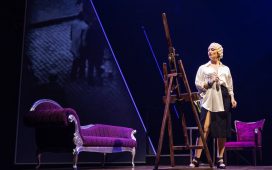Sadeysa Greenaway-Bailey’s career as a stage designer began with a well-judged stint of work experience. “I didn’t just want to make cups of tea and do the photocopying,” she says. So at 14, Greenaway-Bailey was assigned to shadow the creative team at Mahogany Carnival Arts, in Harlesden, London. “I just didn’t leave – I’d go back every summer. Mahogany is where I first learned to weld and do metalwork, before going to university.”
She made carnival costumes, large-scale puppets, kinetic sculptures and props for indoor and outdoor shows; she travelled the world to work on dance, mime and theatre productions and helped make costumes for major sporting ceremonies, including the opening of the Olympics in London 2012, before jumping into the world of design.
Her parents, both chefs, encouraged her creativity. She graduated from Rose Bruford College with a degree in set construction, prop-making and scenery painting in 2010, and soon she was assisting designers on sets. “The first play I assisted on was The Westbridge, which the Royal Court had commissioned at the Bussey Building in Peckham. We had to convert it into a theatrical space and I remember enjoying every minute of it – bringing my ‘making’ skills to it but also taking the opportunity to learn about design. I was training as a designer on the job.”

She graduated from assisting to becoming an associate and then a designer because there were people who believed in her at key moments of her career, she says. The actor Lucian Msamati, then artistic director at tiata fahodzi, was one of them. She had worked with him on a staged reading of The Epic Adventure of Nhamo the Manyika Warrior and his Sexy Wife Chipo and he recommended her to the Tricycle theatre (now the Kiln) when it had its premiere there. “When you take a step up there’s a learning curve but I was surrounded by people who believed in me, and I had the skill and passion for the job.”
She regards mentorship to be central – “Holding doors open and helping people through is really important.” And giving a young designer time and opportunity to experiment, develop and make mistakes is just as important, “especially someone who is black and female. So often, they have to be perfect. It’s allowing people to get things wrong, and therefore grow.”
When she made the switch to designing from making, Greenaway-Bailey felt resistance from some quarters. “People tried to pigeonhole me for a long time, asking ‘Do you do this or that?’ but I do both. I would learn about design through making, and I would learn about making through design. I’ve always seen the partnership and exchange between the makers and the designers. After all, theatre is a collaborative art form and it’s one of the reasons I fell in love with it.”

Recent years have seen more diversity backstage, but it is still largely white and middle-class, she says. “It’s not a problem specific to production design but all realms of theatre. There needs to be more conscious and practical effort, not as a tick-box exercise but a change in thinking.”
Following George Floyd’s killing in the US last year, she co-created an interactive installation for the Young Vic, The Unforgotten, with Anna Fleischle, which addressed the debates around slavery, statues and who history remembers, or forgets, which was placed outside the theatre. She would like to do more projects that inspire and provoke ideas around our civil roles in the future, as well as more community-based work.
Last year, she co-designed the set of the National Theatre’s Death of England with Ultz, whose stage was shaped as a St George’s Cross, and had many innovations in its stagecraft. Its sequel, Death of England: Delroy, was trickier to co-design due to socially distant conditions, she reflects. “We had to learn how to do things in a Covid-secure way, and treat it like a creative problem. Theatre is tactile and intimate and we had to ask ourselves: ‘How can we be two metres [from] each other and still experience this intimate play together?’”

From the CV:
2020: Twenty Twenty, Young Vic (co-designer)
2020: Death of England: Delroy, National Theatre (co-designer)
2020: The Unforgotten, Young Vic (co-creator)
2020: Death of England, National Theatre (co-designer)
2019: Anansi the Spider, Unicorn theatre (designer/maker)
2019: Small Island, National Theatre (design associate)
2016: I Call My Brothers, Gate theatre (designer)
2015: European Games opening ceremony, Baku Olympic Stadium, Azerbaijan (scenic artist)
2014: The Legend of Hamba, tiata fahodzi and Greenwich+Docklands International festival (designer)
2013: The Epic Adventure of Nhamo the Manyika Warrior and His Sexy Wife Chipo, Tricycle theatre and tiata fahodzi (design associate and prop-maker)








